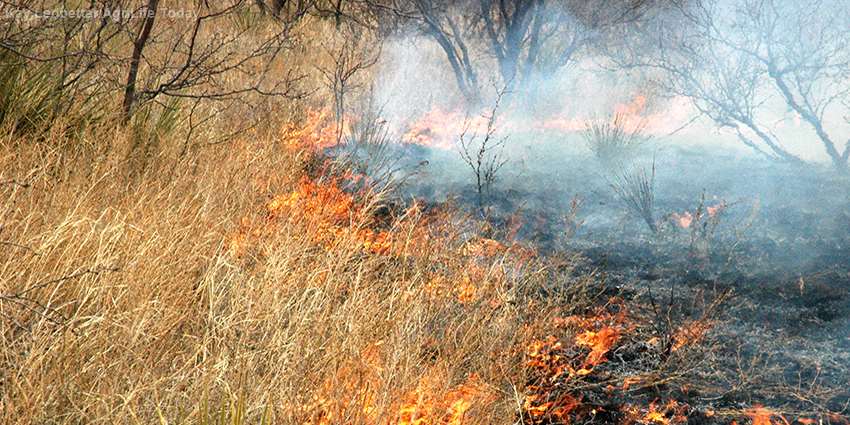Wildfires are a natural phenomenon that can have regenerative properties for ecosystems. According to the U.S. Environmental Protection Agency (EPA), these fires have become more severe and harmful to vegetation, wildlife and water due to climate change.
Texas wildfire trends
Climate change has increased drought prevalence across the state, according to a 2021 report from the Office of the Texas State Climatologist. Prolonged periods of drying create conditions perfect for mega wildfires in Texas and across the country.
“The experience we have been having in the past five years has been different than before,” said Newsha Ajami, Ph.D., chief development officer for research at Lawrence Berkeley National Laboratory’s Earth & Environmental Sciences Area. “We are seeing a lot bigger and more severe fires; the fire season has extended and is happening during different times of the year.”
Texas is in wildfire season almost year-round.
“We can be in a fire season any time we see three to four weeks of extended drying,” said Brad Smith, Predictive Services Department head with the Texas A&M Forest Service.
This year, Texas has seen massive, destructive wildfires, including the Eastland Complex fire in mid-March. Burning over 54,000 acres — about twice the area of Manhattan — the Eastland Complex fire became the largest Texas wildfire to date after surpassing the infamous 34,000-acre Bastrop fire in 2011.
While drought provides a direct relationship between wildfires and water systems, increasing fire prevalence and severity has other direct and indirect consequences for water.
The three buckets
Ajami organizes wildfire impacts on water into three “buckets” — water quality, water quantity and water infrastructure.
Natural and inorganic materials such as carcinogens and metals can be burned and transported through wildfires. These harmful materials negatively impact these three “buckets” of water system health.
“Some of the natural material burned during wildfires can end up in the watersheds and can be washed off to the water bodies as sediment,” Ajami said. “Some of the material in urban areas, for example different carcinogens and different metals, can burn and eventually get washed into our water bodies.”
The influx of these materials into water bodies can impact both ecosystem health and drinking water quality, EPA stated in a 2019 article.
Management strategies for wildfire can also sometimes harm water systems.
“Different entities that are involved in the management process can go and place sandbags and employ chemical fire suppressants — these can impact water quality and degrade water movement,” Ajami said.
Wildfires can also impact snow melt, snow accumulation, infiltration and the runoff process.
“Each of these processes affects the ecosystem’s water budget or available water quantity,” she said.
Finally, wildfires can impact water infrastructure.
“Increased influxes of wildfire sediment create extra flows into reservoirs at the wrong time. This can impact the management and strategies that are around infrastructure management,” Ajami said.
Utilities are dealing with excessive sediments and pollutants that can end up in their water system. Utilities are working to understand the effectiveness of their filtration systems with these added materials from wildfires and how to mitigate current and predicted issues.
She added that wildfires can also physically damage infrastructure components such as distribution pipes and pumps. For example, wildfires can melt underground water pipes and taint water with chemicals, rendering water unsafe to drink.
Looking to the future
The increasingly unpredictable wildfire situation makes water management difficult for utilities and water professionals, who mainly work post-fire to mitigate the impacts of wildfire on water quality, quantity and infrastructure.
“Whether water quality, quantity or infrastructure, these fires can impact water access in different ways,” Ajami said. “It can impact our aquatic ecosystem, it can impact our food chain, there are many indirect and direct implications to wildfire in the water sphere.”
To address these issues, Ajami said that there is a lot of effort going into data collection and information gathering to better understand the wildfire situation.
“There's a lot of investment right now going on in watershed modeling, pre- and post-wildfires, to better understand how the different hydrologic processes are impacted due to wildfires and how that will impact water and infrastructure management,” she said.
Ajami said that more interdisciplinary research focused on post-fire measurements and matrices to understand impacts of wildfire will be needed as wildfires continue to increase.
“We are experiencing more and more of these, but what kind of understanding do we need to make sure we capture the social, environmental and economic impacts of wildfires?” Ajami said. “We have to be better at capturing those elements as part of our pre- and post-fire policy actions.”


